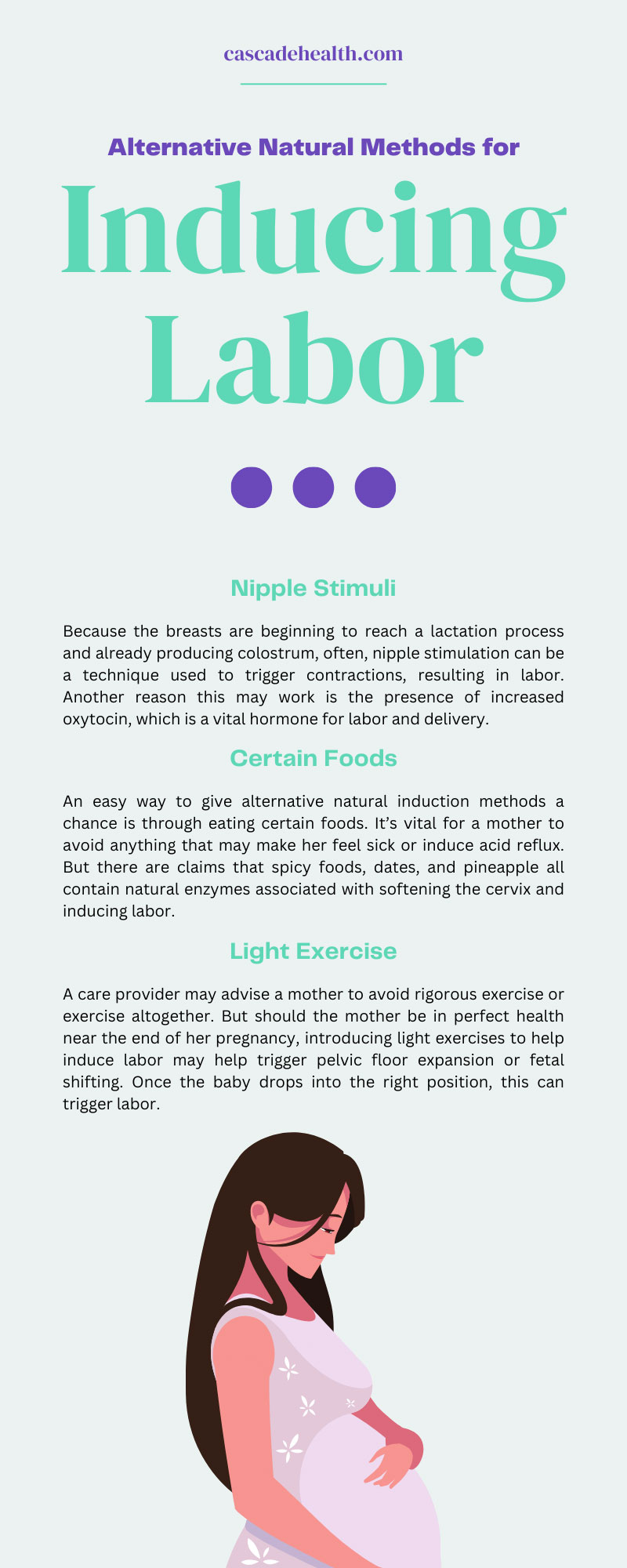Alternative Natural Methods for Inducing Labor
It’s common for mothers to wish for nothing but smooth delivery measures when they find out about their pregnancy. It’s a challenging, uphill climb to reach labor, and it’s an even more significant accomplishment to deliver a healthy baby. Sometimes, nature has other plans. And when things don’t progress on their own, induction may be the most appropriate next step.
Signs Induction Is Necessary
Classifying a pregnancy as full term does not have an exact frame of reference. However, there is an ideal window a care provider uses to consider their patients full term and ready to have a baby. In general, a full-term pregnancy falls into the gestational frame of 38 weeks to 40 weeks and six days. Anything outside this box may have a new label that signals early, late, or post term. And in these circumstances, care providers may begin discussing labor induction methods with their patients to ensure optimal delivery outcomes and fetal viability.
So how will a care provider introduce the idea of induction, and when is it necessary? In the event a woman’s pregnancy inches outside of full term and into late term, this means she has reached 41 gestational weeks and counting. Those next six days can be telling for a woman and her pregnancy, so the induction discussion may be on the table but not imminent.
As a mother heads into her 42nd week of gestation, induction may be the most feasible option to move things in the right direction. It’s not uncommon to reach this stage of pregnancy. While healthcare professionals cannot identify the source of these outcomes, it’s easy to speculate a variety of reasons why a woman enters the post-term labor and delivery window. A few suggested reasons include the following:
- A woman is experiencing her first pregnancy and child
- Genetic predisposition
- The hormonal matrix at play
It’s essential to note that these causes are not definite, and a care provider may draw other conclusions.
Associated Risks With Post-Term Labor and Delivery
In the event an expecting mother reaches the post-term labor and delivery window, the conversations surrounding induction will begin. It’s essential to understand the associated risks with these labor and delivery circumstances to easily accept induction measures, as many mothers may have feared this outcome all along.
Not only is the mother at increased risk, but the baby is also. The longer the baby spends in its mother’s womb, the larger it will grow. This can become tricky for vaginal deliveries, so if the mother intends and is capable of vaginal delivery, it’s ideal to induce her.
Another risk for the baby is the potential for a meconium release. The meconium is the infant’s first stool after birth. However, it’s possible for the baby to release the meconium while still inside the womb, which leaves them exposed to inhalation resulting in lung issues.
On the other hand, there are risks for the mother with post-term labor and delivery. One is the baby’s size making a vaginal delivery more challenging and leaving her subject to tearing. Other things like slow laboring or cesarean delivery are also common.
Can My Midwife Perform a Safe Induction for Me?
A care provider or certified nurse midwife can perform a safe and ethical induction using certified medical instruments. But they will always weigh the benefits, causes, and risks associated with the intervention to ensure the mother is a viable candidate for induction and the chosen methods are safe for the baby.
A few considerations for care providers to lean toward induction measures typically include things such as low fluids, infection concerns, and the overall health and well-being of the mother and baby. In some cases, the mother may be experiencing a menu of health conditions as a result of pregnancy or post-term pregnancy. In these instances, a certified nurse midwife may heavily advise an induction.
Common medical conditions that midwives use as induction parameters typically include gestational diabetes, toxemia of the pregnancy, misalignment of blood pressure indicators, and rhesus.
Midwifery Induction Methods
There are various techniques for induction in the maternity medical field. A care provider will use the method that best suits the mother and the baby. Some processes use medication, while others require the use of instruments.
Hormonal Induction
Hormonal induction is the use of natural chemical compounds to help trigger the labor process within the mother’s body. A provider can use oxytocin or prostaglandins to attempt to thin or soften the cervix with the primary goal of dilating the cervix to begin labor.
Amniotomy
In contrast to a hormonal induction, a provider can use amnio-based tools to manually rupture the sac and trigger labor. The baby rests inside the amniotic sac, and when that sac is ruptured, the baby can receive the signals for labor and delivery. This option is only feasible when the mother dilates enough for the sac to be readily accessible by a provider.
Cervical Ripening
Manual cervix ripening is the insertion of a balloon-like catheter directly into the cervix. Sometimes, providers leave the balloon structure as is or release a substance to aid in fluid absorption.
Alternative Natural Induction Methods
While risks are associated with anything, it’s advantageous for expecting mothers to know how they can lend a hand in alternative natural induction measures. These techniques are not guaranteed, but some women claim they did the trick. In instances where mothers wish to avoid drastic intervention methods and are full term, performing natural procedures is simple and relatively safe for at-home efforts.
Nipple Stimuli
Because the breasts are beginning to reach a lactation process and already producing colostrum, often, nipple stimulation can be a technique used to trigger contractions, resulting in labor. Another reason this may work is the presence of increased oxytocin, which is a vital hormone for labor and delivery.
Certain Foods
An easy way to give alternative natural induction methods a chance is through eating certain foods. It’s vital for a mother to avoid anything that may make her feel sick or induce acid reflux. But there are claims that spicy foods, dates, and pineapple all contain natural enzymes associated with softening the cervix and inducing labor.
Light Exercise
A care provider may advise a mother to avoid rigorous exercise or exercise altogether. But should the mother be in perfect health near the end of her pregnancy, introducing light exercises to help induce labor may help trigger pelvic floor expansion or fetal shifting. Once the baby drops into the right position, this can trigger labor.
It’s essential to note that all at-home induction methods are not proven to be effective, and an expecting mother may still require maternal intervention from her overseeing care team.
Cascade Health Care offers certified nurse midwives and overseeing maternal care providers a range of essential tools and instruments to ensure safe, ethical induction practices. Browse our selection of amnicots and amnihooks for sale, or connect with us to learn more.

Recent Posts
-
Assessing Musculoskeletal Blood Flow Using Dopplers
When it comes to diagnosing and managing conditions related to musculoskeletal blood flow, precision
-
How To Talk to a Patient About Their Birth Plan
When supporting parents-to-be, discussing their birth plan is a crucial element of providing patient



